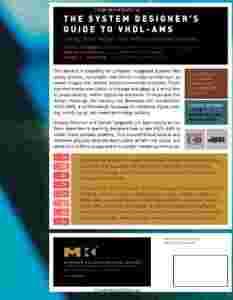|
 |
Autor: Peter J. Ashenden , Gregory D. Peterson , Darrell A. Teegarden , Peterson
Wydawnictwo: Morgan Kaufmann Publishers In; Pap/Cdr edition
Data wydania: 10 Sep 2002
Ilość stron: 880
Wymiary książki: 4 x 18.3 x 23.3 cm
Rodzaj okładki: Paperback
ISBN-13: 978-[zasłonięte][zasłonięte]86074
978-[zasłonięte][zasłonięte]86074A
The demand is exploding for complete, integrated systems that sense, process, manipulate, and control complex entities such as sound, images, text, motion, and environmental conditions. These systems, from hand-held devices to automotive sub-systems to aerospace vehicles, employ electronics to manage and adapt to a world that is, predominantly, neither digital nor electronic. To respond to this design challenge, the industry has developed and standardized VHDL-AMS, a unified design language for modeling digital, analog, mixed-signal, and mixed-technology systems. VHDL-AMS extends VHDL to bring the successful HDL modeling methodology of digital electronic systems design to these new design disciplines. Gregory Peterson and Darrell Teegarden join best-selling author Peter Ashenden in teaching designers how to use VHDL-AMS to model these complex systems. This comprehensive tutorial and reference provides detailed descriptions of both the syntax and semantics of the language and of successful modeling techniques. It assumes no previous knowledge of VHDL, but instead teaches VHDL and VHDL-AMS in an integrated fashion, just as it would be used by designers of these complex, integrated systems. This book explores the design of an electric-powered, unmanned aerial vehicle system (UAV) in five separate case studies to illustrate mixed-signal, mixed-technology, power systems, communication systems, and full system modeling. It includes a CD-ROM with code for all the examples and case studies in the book, an educational model library, a quick reference guide for VHDL-AMS, a syntax reference from Appendix E in the book, links to VHDL-AMS resources and Mentor Graphics SystemVision software, which provides a simulation and modeling environment with a schematic entry tool, a VHDL-AMS simulator, and a waveform viewing facility.
|
|

